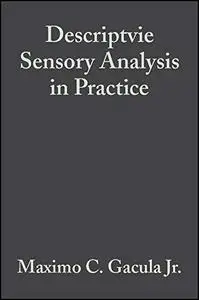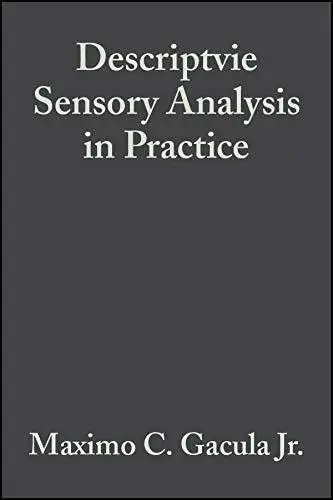Descriptive Sensory Analysis in Practice By
1997 | 698 Pages | ISBN: 0917678370 | PDF | 10 MB
1997 | 698 Pages | ISBN: 0917678370 | PDF | 10 MB
In defining sensory properties of products, descriptive techniques that utilize trained panels are used. Arthur D. Little, Inc. pioneered a desriptive technique in the 1950's known as the "Flavor Profile" that laid the foundation for the development of current desriptive techniques used today in academia and industry. Several collections of published papers are reprinted in this book. The main areas covered include dairy products, meats, alcoholic beverages, textile materials and general applications. In addition, Dr. Gacula has prepared 40 pages of new text material on (1) Descriptive Sensory Analysis Methods, and (2) Computer Software. Methods for statistical systems (SAS) computer programs are providedContent: Chapter 1 Introduction (pages 1–4): Chapter 1.1 Descriptive Sensory Analysis Methods (pages 5–13): Chapter 1.2 Flavor Profiles: A New Approach to Flavor Problems (pages 15–22): S.E. Cairncross and L.B. SjostromChapter 1.3 Sensory Evaluation by Quantitative Descriptive Analysis (pages 23–34): Herbert Stone, Joel Sidel, Shirley Oliver, Annette Woolsey and Richard C. SingletonChapter 1.4 The Selection and Use of Judges for Descriptive Panels (pages 35–50): Katherine Zook and Colleen WessmanChapter 1.5 Examining Methods to Test Factor Patterns for Concordance (pages 51–61): Elizabeth I. Fischman, Kathleen J. Shinholser and John J. PowersChapter 1.6 Quantitative Descriptive Analysis (pages 53–69): Herbert Stone, Joel L. Sidel and Jean BloomquistChapter 1.7 Importance of Reference Standards in Training Panelists (pages 71–76): Barbara A. RaineyChapter 1.8 The Importance of Language in Describing Perceptions (pages 77–89): Gail Vance Civille and Harry T. LawlessChapter 1.9 Illustrative Examples of Principal Components Analysis (pages 91–108): W.T. Federer, C.E. McCulloch and N.J. Miles?McDermottChapter 1.10 Reducing the Noise Contained in Descriptive Sensory Data (pages 109–125): K.L. Bett, G.P. Shaffer, J.R. Vercellotti, T.H. Sanders and P.D. BlankenshipChapter 1.11 Experts Versus Consumers: A Comparison (pages 127–145): Howard R. MoskowitzChapter 2 Dairy Products (page 147): Chapter 2.1 Sensory Aspects of Maturation of Cheddar Cheese by Descriptive Analysis (pages 149–162): J.R. Piggott and R.G. MowatChapter 2.2 Sensory Profiling of Dulce de Leche, a Dairy Based Confectionary Product (pages 163–184): Guillermo Hough, Nicholas B. Ratchell and Douglas B. MacDougallChapter 2.3 Sensory Properties of Fermented Milks: Objective Reduction of an Extensive Sensory Vocabulary (pages 185–199): E. Anthony Hunter and D. Donald MuirChapter 2.4 Measuring Sources of Error in Sensory Texture Profiling of Ice Cream (pages 201–217): Bonnie M. King and Paul ArentsChapter 2.5 Effects of Starter Cultures on Sensory by Quantitative Descriptive Analysis Properties of Set?Style Yoghurt Determined (pages 219–234): H. Rohm, Mesa Kovac and W. KneelChapter 2.6 The Use of Standardized Flavor Languages and Quantitative Flavor Profiling Technique for Flavored Dairy Products (pages 235–252): Chantal R. StampanoniChapter 3 Meats (page 253): Chapter 3.1 Development of a Texture Profile Panel for Evaluating Restructured Beef Steaks Varying in Meat Particle Size (pages 255–266): B.W. Civille and G.V. SjostromChapter 3.2 A Standardized Lexicon of Meat WOF Descriptors (pages 267–275): Peter B. Johnsen and Gail Vance CivilleChapter 3.3 Development of Chicken Flavor Descriptive Attribute Terms Aided by Multivariate Statistical Procedures (pages 275–287): B.G. LyonChapter 3.4 A Technique for the Quantitative Sensory Evaluation of Farm?Raised Catfish (pages 289–299): Peter B. Johnsen and Carol A. KellyChapter 4 Alcoholic Beverages (page 301): Chapter 4.1 Sensory Profiling of Beer by a Modified QDA Method (pages 303–312): James M. Mecredy, John C. Sonnemann and Susan J. LehmannChapter 4.2 Factor Analysis Applied to Wine Descriptors (pages 313–334): Louise S. Wu, R.E. Bargmann and John J. PowersChapter 4.3 Descriptive Analysis and Quality Ratings of 1976 Wines from Four Bordeaux Communes (pages 335–350): Ann C. Noble, Anthony A. Williams and Stephen P. LangronChapter 4.4 Sensory Panel Training and Screening for Descriptive Analysis of the Aroma of Pinot Noir Wine Fermented by Several Strains of Malolactic Bacteria (pages 351–369): Mina Mcdaniel, Lee Ann Henderson, Barney T Watson and David HeatherbellChapter 4.5 Descriptive Analysis of Pinot Noir Wines from Carneros, Napa and Sonoma (pages 371–381): Jean?Xavier Guinard and Margaret CliffChapter 4.6 Descriptive Analysis for Wine Quality Experts Determining Appellations by Chardonnay Wine Aroma (pages 383–401): L.P. McCloskey, M. Sylvan and S.P. ArrheniusChapter 5 Textile Materials (page 403): Chapter 5.1 The Judgment of Harshness of Fabrics (pages 405–416): Herman Bogaty, Norman R.S. Hollies and Milton HarrisChapter 5.2 Measurement of Fabric Aesthetics Analysis of Aesthetic Components (pages 417–442): R.H. BrandChapter 5.3 Development of Terminology to Describe the Handfeel Properties of Paper and Fabrics (pages 443–456): Gail Vance Civille and Clare A. DusChapter 6 General Applications (page 457): Chapter 6.1 The Use of Free?Choice Profiling for the Evaluation of Commercial Ports (pages 459–475): Anthony A. Williams and Steven P. LangronChapter 6.2 A Comparison of the Aromas of Six Coffees Characterised by Conventional Profiling, Scaling Methods Free?Choice Profiling and Similarity (pages 477–491): Anthony A. Williams and Gillian M. ArnoldChapter 6.3 Evaluation and Applications of Odor Profiling (pages 493–506): M.A. Jeltema and E.W. SouthwickChapter 6.4 Component and Factor Analysis Applied to Descriptors for Tea Sweetened with Sucrose and with Saccharin (pages 507–518): Nancy M. Rogers, Rolf E. Bargmann and John J. PowersChapter 6.5 Intensity Variation Descriptive Methodology: Development and Application of a New Sensory Evaluation Technique (pages 519–531): Harvey H. GordinChapter 6.6 Development of a Lexicon for the Description of Peanut Flavor (pages 533–542): Peter B. Johnsen, Gail Vance Civille, John R. Vercellott, Timothy H. Sanders and Clare A. DusChapter 6.7 Sensory Measurement of Food Texture by Free?Choice Profiling (pages 543–560): Richard J. Marshall and Simon P.J. KirbyChapter 6.8 Taste Descriptive Analysis: Concept Formation, Alignment and Appropriateness (pages 561–594): M. O'Mahony, Rothman T. Ellison, D. Shaw and L. ButeauChapter 6.9 Control Chart Technique: A Feasible Approach to Measurement of Panelist Performance in Product Profile Development (pages 595–611): Miflora M. Gatchalian, Sonia Y. De Leon and Toshimasa YanoChapter 6.10 Comparison of Three Descriptive Analysis Scaling Methods for the Sensory Evaluation of Noodles (pages 613–625): Flor Crisanta F. Galvez and Anna V.A. ResurreccionChapter 6.11 A Comparison of Free?Choice Profiling and the Repertory Grid Method RIV the Flavor Profiling of Cider (pages 627–639): J.R. Piggott and M.P. WatsonChapter 6.12 Descriptive Analysis of Oral Pungency (pages 641–652): Margaret Cliff and Hildegarde HeymannChapter 6.13 A Comparison of Descriptive Analysis of Vanilla by Two Independently Trained Panels (pages 653–664): Hildegarde HeymannChapter 6.14 Multivariate Analysis of Conventional Profiling Data: A Comparison of a British and a Norwegian Trained Panel (pages 665–686): Einar Risvik, Janet S. Colwill, Jean A. McEwan and David H. LyonChapter 7 Computer Software (page 687): Chapter 7.1 Software Packages (pages 699–710):



